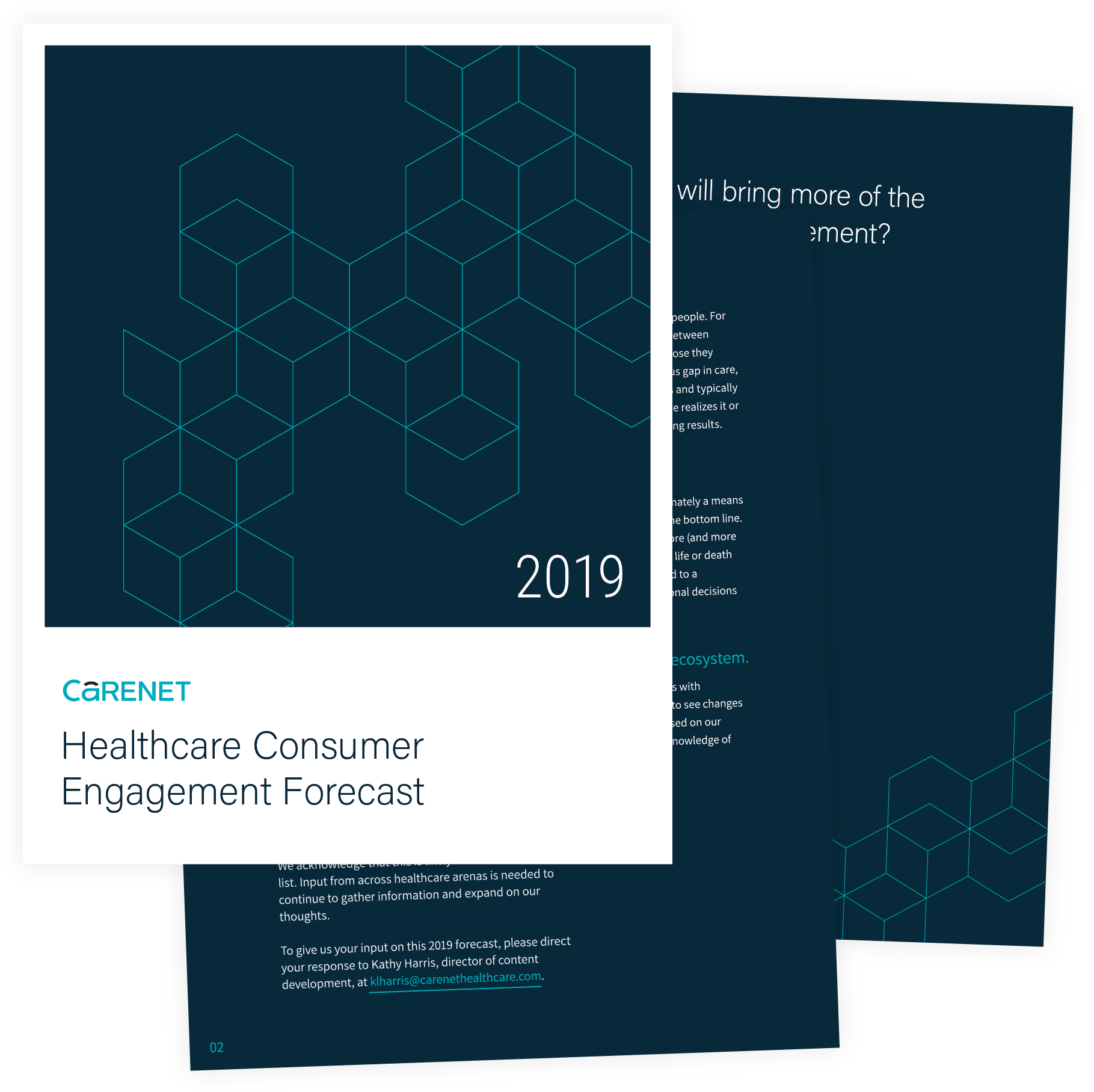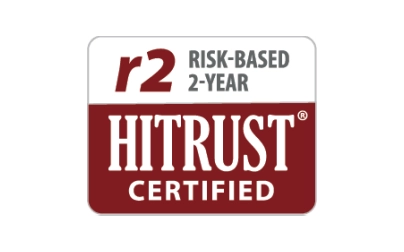Think next year will bring more of the same for healthcare engagement? Think again.
Consumer engagement and health plan member engagement are changing, and it’s important for the healthcare industry to reflect on the changes we’re experiencing and discuss those we see on the horizon. At Carenet Health, our goal is to help foster those conversations. That’s why we’re introducing the Healthcare Consumer Engagement Forecast — developed to provide a set of predictions on what the industry can expect in the areas of patient and health plan member engagement in the coming year. It’s designed to be a dynamic forecast, continually shaped and revisited based on further industry insights.
But first: what do we mean by engagement in healthcare?
It’s no secret that the term “consumer engagement can mean different things to different people. (One of the top searches we see is “Member Engagement Health Plans.”) For this exercise, we believe it is an all-encompassing phrase that represents the interactions between organizations and individuals that, when optimized, can build trusted relationships with those they serve. Those interactions might have significantly diverse immediate goals (closing a serious gap in care, transitioning a prescription to mail order), but they all occur through personal connections and typically in conversations over multiple channels. And they all generate an emotion, whether anyone realizes it or not. It’s something modern retailers have harnessed and continue to refine with outstanding results.
What’s really at stake in patient and health plan member engagement.
Much like industries outside of healthcare, consumer engagement in our world is still ultimately a means to an end. We engage to influence. We engage to strengthen ties. We engage to improve the bottom line. However, the end result has much greater consequences. What’s at stake is not simply more (and more frequent) spend. It’s an action that might impact daily living. It’s a decision that may have life or death consequences. It’s an exchange that gives peace of mind. And when done right, it can lead to a persistent loyalty that binds a member or a patient to an organization through very personal decisions and outcomes.
Engagement happens at every intersection of the healthcare ecosystem.
Engagement happens at every intersection along the patient journey, from when a consumer is first interacting with and choosing a health plan to the point at which a patient is utliizing or paying for care services. At Carenet, we often serve as a conduit among stakeholders—connecting on a daily basis with healthcare consumers, payers, providers and service-providing partners. This allows us to see changes at a macro level. The insights we’ve shared in this forecast are the result of that view, based on our in-depth work with more than 100 U.S. health plans and health systems, as well as our knowledge of innovations in consumer engagement inside and outside of healthcare.
We acknowledge that this is likely not a complete list, regardless if you’re discussing patient engagement or wellness engagement or searching for “member engagement health plans.” Input from across healthcare arenas is needed to continue to gather information and expand on our thoughts.
2019
A Year of Opportunity
The outlook for patient engagement and health plan member engagement in 2019 appears overwhelmingly positive, with leaders further embracing the short- and long-term return on investment and value that highly consumer-centric engagement can deliver.
However, it will still take substantial effort by forward-thinking organizations to push member and patient engagement to new levels. Improved sharing and optimization of best practices across the industry will be key to moving from today’s theories and practices to tomorrow’s next-generation healthcare engagement. For the industry as a whole, that signals significant opportunity.
Here are our top 10 specific predictions for the coming year.
01. The pace of change will quicken. Healthcare has been in a bit of a holding pattern as it struggles with the transition to value-based care and policy uncertainties. But consumer engagement is something organizations can embrace no matter what changes come down the pike in the future. Importantly, engagement also stands to help organizations set themselves apart in an increasingly competitive industry—one in which brand recognition in a market area may be high, but true brand distinction is low. Heightened payer and provider competition will combine with much higher consumer expectations to force change at a faster rate than we’ve seen in the last few years. Leaders will have to think critically about how they approach healthcare consumer engagement as it moves farther away from being largely a cost center and closer to being a true market advantage. Consumers will demand more experiences and a higher level of personalization that mirror the B2C arena—or they’ll move their care and benefits elsewhere.
02. Technology will continue to be fundamental for successful interactions. Consumers are demonstrating a rising need for connection in healthcare. They want more time with their care providers. They want payers who understand their individual level of healthcare literacy. They often need help figuring out what to do next when they’re overwhelmed and can’t take action on their own. Payers and providers that recognize these needs and approach engagement creatively will reap the benefits. But successful interactions of this kind will be strongly rooted in technology. However ironic it may sound, emotional connections can’t be delivered without the amplified use of data and technology. That’s because technology will be the only way the industry can deliver the highly relevant, customized information that meets highly specific member and patient needs and expectations. In addition, multiple digital communications channels are necessary today. Members and patients will expect to begin a conversation with your organization on one channel and continue it across others.
03. Consumer communication preferences will remain in flux. Assuming that what consumers want in January is the same as they’ll want in November next year will be a mistake. Yes, the use of digital will continue to increase, but health plans and providers will need to invest in surveying their populations more often to find out how individuals wish to be contacted and updated for different types of engagement. A notice about getting a flu shot might be fine via Facebook message, but interaction with a health coach may require voice-to-voice interaction. Email might be welcomed now, but in three months, that could change due to any number of personal reasons. Individual preferences might be different during different times of year, as well. And of course, grouping channel preferences by demographic or other attributes is not a shortcut for knowing your individual consumers—and will likely result in lower engagement performance.
04. System integration between engagement partners and payers/providers will become faster and easier. Flexible technology platforms have arrived in full force, with simple integration options. This will mean an investment in change will be needed on both sides, and soon. Data and reporting on separate systems will no longer deliver the kind of seamless engagement experiences payer and providers need. Fortunately, early adopters have paved the way for the industry to embrace easily integrated, “plug-and-play” engagement systems. This transition will also mean it will be far less complicated for organizations to switch engagement partners as business needs or partner performance change.
05. Telehealth engagement will move away from siloed services. As consumers get more comfortable with interacting with care professionals via virtual channels, this form of healthcare engagement will increase in importance to both payers and providers. And as importance and utilization grow, once-separate forms of telehealth will begin to combine for an all-inclusive virtual care experience. That experience will provide a single “front door” point of contact, much like a physical provider office. If a consumer needs nurse advice, she calls one number. That same number points her to a physician virtual consult, whether it’s for a dermatology issue, surgery complication or behavioral health concern. It’s the future of virtual care, and we’ll see it really begin to take shape next year.
06. Virtual care will be offered at no cost to consumers by a number of plans and providers with their own plans. It’s a new idea, with the waters tested by a few pilot programs in 2018. But as more plans find innovative ways to shift how telehealth is financed and innovative ways of increasing the use of virtual services, cost-savings will emerge. They’ll emerge from more care gaps closed, increased ER diversion and reduced readmissions, among other factors. Free-to-members virtual care will be a game-changing competitive offering and an exciting market development. It will also be a cost-effective way to help members get the appropriate level of care, quickly.
07. Outreach initiatives will produce better results. Outbound engagement programs, such as those that close gaps in care, enroll people in health coaching programs or complete health risk assessments, will reach and activate more people than in the past. Why? Because the industry will be getting better and better at understanding individual needs and preferences. Disparate data will paint more holistic pictures of patients and members that will fuel enhanced, one-to-one level conversations and motivational strategies. And more and more organizations will begin to capitalize on artificial intelligence that anticipates and learns individual behavior—and gets more intelligent with every interaction. In addition, technology will allow all of that personalization on a larger scale.
08. More healthcare and health plan member engagement partners will get paid based on performance. Shared risk is making its way into new areas in the industry at the same time the contract landscape in consumer engagement partnerships is due for a disruptive reset. That convergence means collaborative performance agreements are evolving as a way for all stakeholders to be held accountable for engagement initiatives that produce guaranteed results. Increased transparency between healthcare organizations and their service partners will be the foundation of this new way of business. Program goals and specific business metrics will be more clearly defined and outcomes, more measurable. That’s a win-win for all players.
09. Diverse staffing models will become more commonplace. The industry needs more efficient and effective engagement delivery, and that need will motivate payers and providers to fold different kinds of staffing approaches into their conventional organizational toolbox. Those approaches will include virtual workplaces, i.e., work-from-home and remote staffing—which not only free up internal physical resources, but also allow an organization to tap into the best talent available with no geographic barriers. Organizations will also be evaluating the use of global vendor resources for cost-effective, round-the-clock staffing. Efficient ramp-up and ramp-down staffing solutions are also on the table. Most healthcare organizations don’t have the flexibility to increase and decrease staffing as engagement demands fluctuate. So instead of disrupting internal resource models, the new year will usher in a new openness to partnerships. That receptiveness will be thanks to even tighter budgets and potentially declining revenue that could impact traditional hiring. Those partnerships might take the form of resource-sharing among like-minded organizations or the establishment of highly collaborative staffing agreements with specialty vendors.
10. Payers and providers will invest in enterprise-wide engagement. Perhaps most importantly, as the need for more types (and more personalized and relevant) consumer engagement increases next year, the industry C-suite will challenge their teams to take an integrated, 360-degree view of how those engagement programs are implemented. Piecemeal, separate and status quo programs will no longer make the cut and can’t deliver the necessary seamless engagement experience consumers need and expect. In addition, enterprise-wide alignment stands to reduce inefficiencies, increase relationship-building opportunities and usher in critical cost-savings to a marketplace in need of a shot in the arm.



